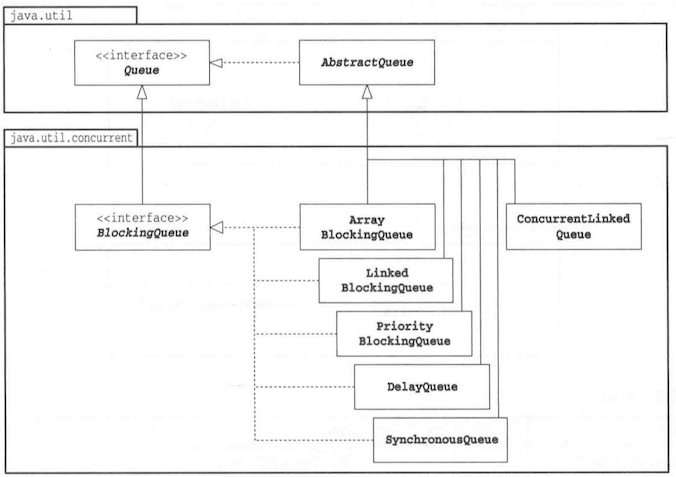Collection
1 List¶
CopyOnWriteArrayList¶
CopyOnWriteArrayList允许并发读,读操作是无锁的,性能较高。至于写操作,比如向容器中添加一个元素,则首先将当前容器复制一份,然后在新副本上执行写操作,结束之后再将原容器的引用指向新容器2。
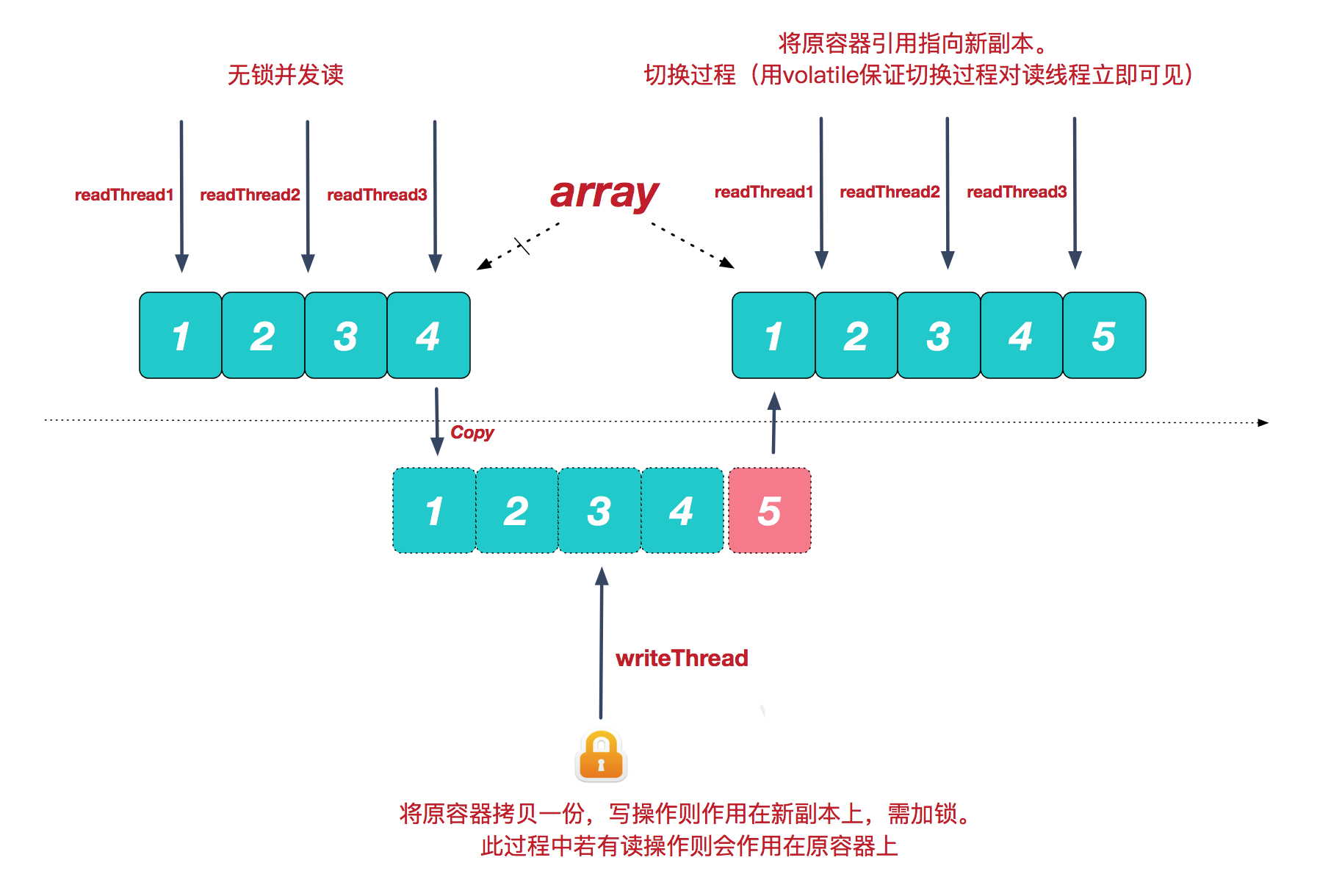
// Appends the specified element to the end of this list.
public boolean add(E e) {
final ReentrantLock lock = this.lock; //重入锁
lock.lock(); //加锁
try {
Object[] elements = getArray();
int len = elements.length;
//拷贝原容器,长度为原容器长度加一
Object[] newElements = Arrays.copyOf(elements, len + 1);
//在新副本上执行添加操作
newElements[len] = e;
//将原容器引用指向新副本
setArray(newElements);
return true;
} finally {
lock.unlock();//解锁啦
}
}
2 Map¶
Map作为一个接口,主要有HashMap, HashTable, LinkedHashMap, TreeMap等实现
HashTable是历史遗留类,线程安全LinkedHashMap保存了插入顺序TreeMap可以排序
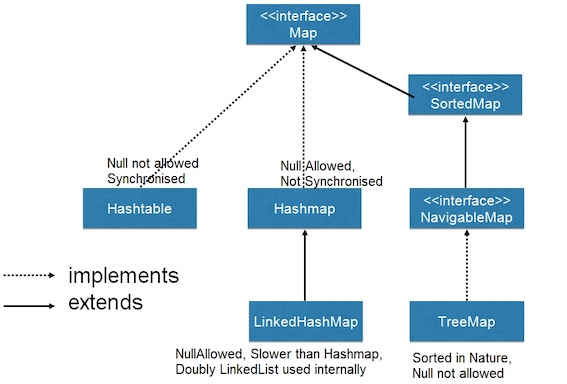
HashMap¶
HashMap在JDK8之前由数组+链表组成,其最坏时间复杂度是O(n)
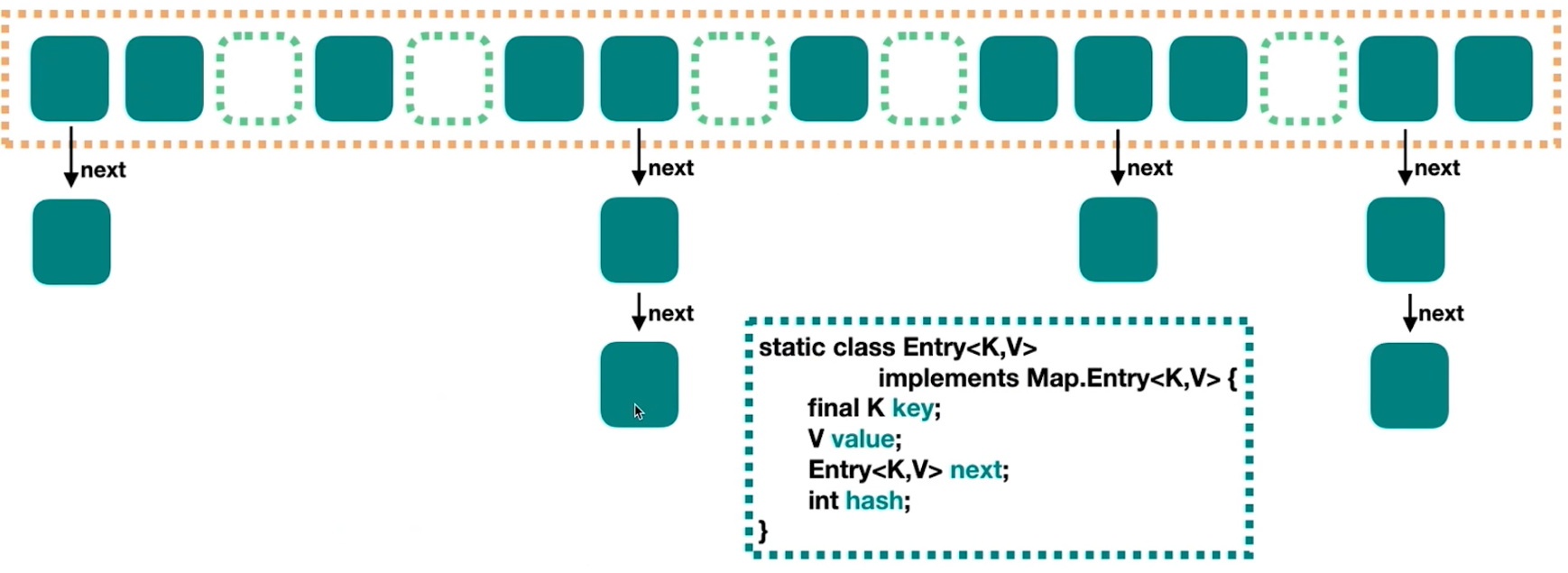
HashMap在JDK8之后由数组+链表+红黑树组成,最坏时间复杂度为O(\log n)
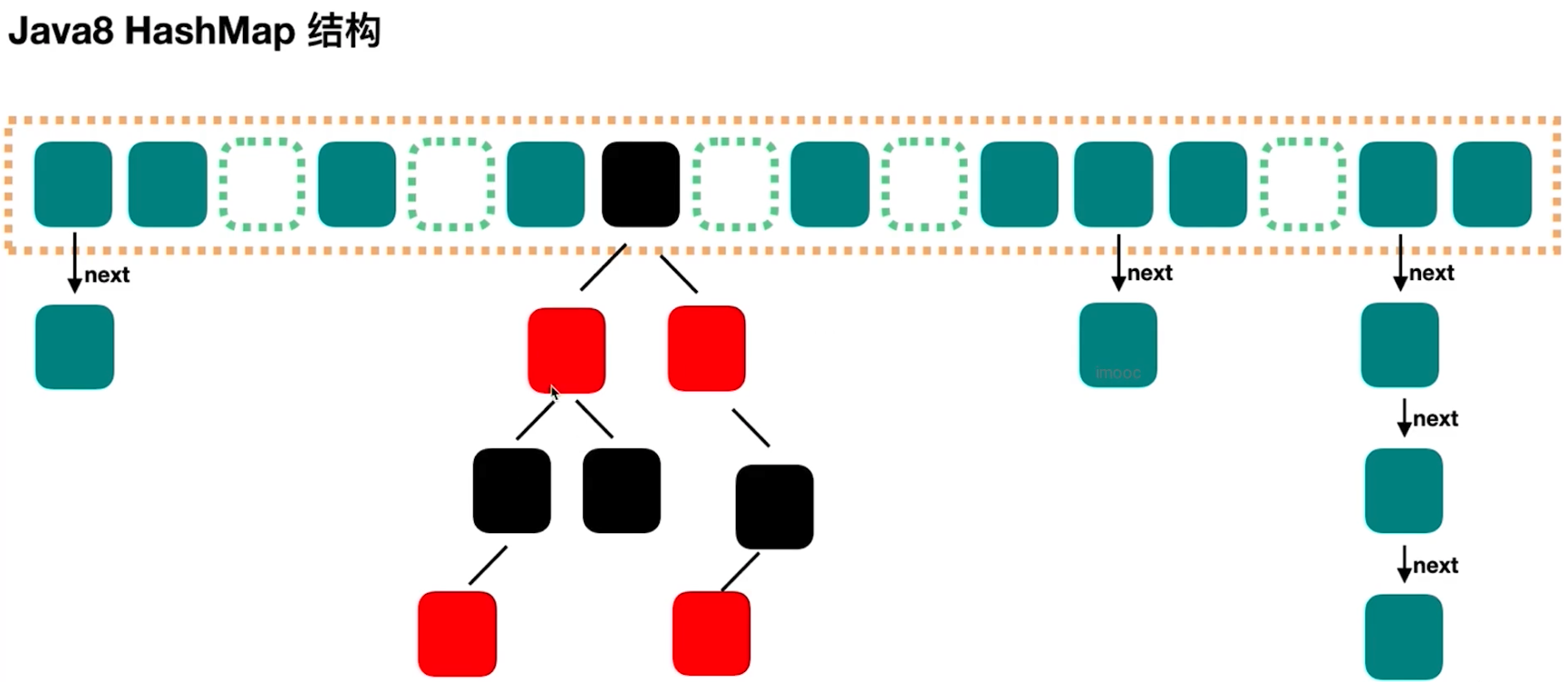
//创建HashMap时未指定初始容量情况下的默认容量
static final int DEFAULT_INITIAL_CAPACITY = 1 << 4;
//HashMap的最大容量
static final int MAXIMUM_CAPACITY = 1 << 30;
//HashMap默认的装载因子,当HashMap中元素数量超过 容量*装载因子 时,进行resize()操作
static final float DEFAULT_LOAD_FACTOR = 0.75f;
//用来确定何时将解决 hash 冲突的链表转变为红黑树
static final int TREEIFY_THRESHOLD = 8;
// 用来确定何时将解决 hash 冲突的红黑树转变为链表
static final int UNTREEIFY_THRESHOLD = 6;
// 当需要将解决 hash 冲突的链表转变为红黑树时,需要判断下此时数组容量
// 若是由于数组容量太小(小于MIN_TREEIFY_CAPACITY)导致的 hash 冲突太多
// 则不进行链表转变为红黑树操作,转为利用 resize() 函数对 hashMap 扩容
static final int MIN_TREEIFY_CAPACITY = 64;
//保存Node<K,V>节点的数组
transient Node<K,V>[] table;
//由hashMap中Node<K,V>节点构成的set
transient Set<Map.Entry<K,V>> entrySet;
//记录 hashMap 当前存储的元素的数量
transient int size;
//记录 hashMap 发生结构性变化的次数(注意 value 的覆盖不属于结构性变化)
transient int modCount;
//threshold的值应等于 table.length * loadFactor, size 超过这个值时进行 resize()扩容
int threshold;
//记录 hashMap 装载因子
final float loadFactor;
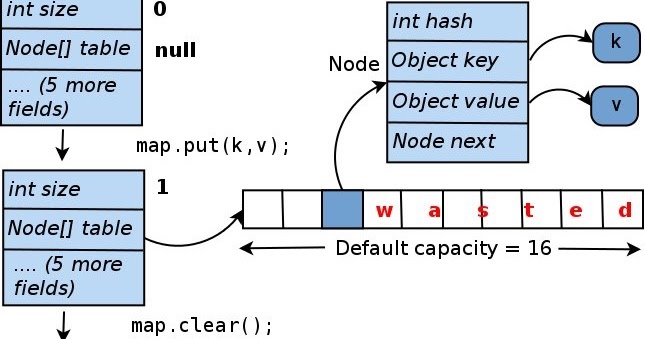
static class Node<K,V> implements Map.Entry<K,V> {
final int hash; // 哈希值
final K key; // 键
V value; // 值
Node<K,V> next; // 下一个节点
}
put¶
put方法的逻辑
- 如果
HashMap未被初始化,则初始化 - 对Key求Hash值,然后再计算下标
- 如果没有碰撞,直接放入桶中
- 如果碰撞了,以链表的方式链接到后面
- 如果链表长度超过阈值,就把链表转成红黑树
- 如果链表长度低于6,就把红黑树转回链表
- 如果节点已经存在就替换旧值
- 如果桶满了,那就扩容
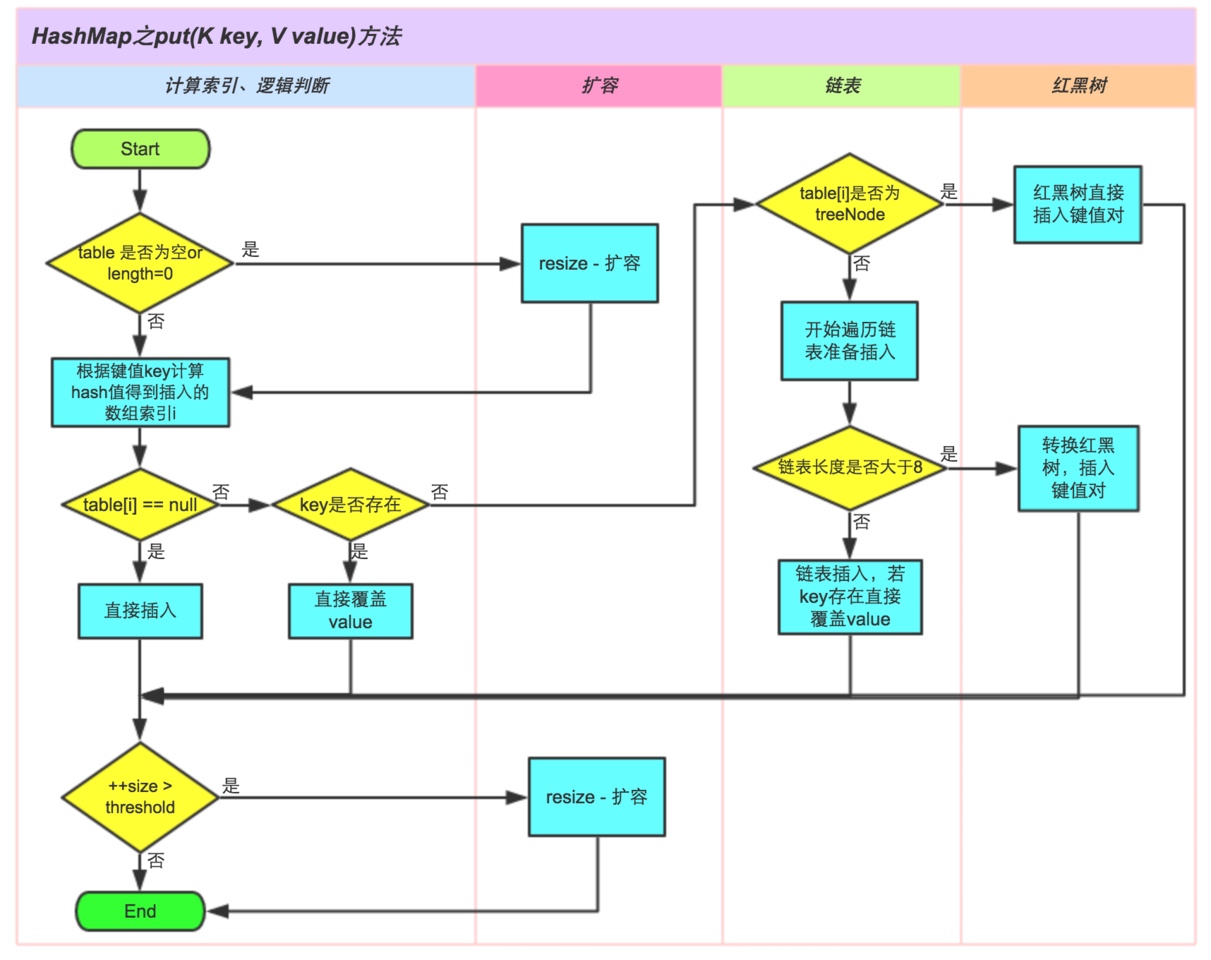
final V putVal(int hash, K key, V value, boolean onlyIfAbsent,
boolean evict) {
Node<K,V>[] tab; Node<K,V> p; int n, i;
if ((tab = table) == null || (n = tab.length) == 0) // hashmap为空
n = (tab = resize()).length;
if ((p = tab[i = (n - 1) & hash]) == null) // 该位置上没有元素
tab[i] = newNode(hash, key, value, null);
else {
Node<K,V> e; K k;
// 已经存在,直接替换
if (p.hash == hash &&
((k = p.key) == key || (key != null && key.equals(k))))
e = p;
// 当前数组位置是红黑树
else if (p instanceof TreeNode)
e = ((TreeNode<K,V>)p).putTreeVal(this, tab, hash, key, value);
else {
// 在链表中添加元素
for (int binCount = 0; ; ++binCount) {
if ((e = p.next) == null) {
// 添加载链表末尾
p.next = newNode(hash, key, value, null);
if (binCount >= TREEIFY_THRESHOLD - 1) // -1 for 1st
treeifyBin(tab, hash);
break;
}
if (e.hash == hash &&
((k = e.key) == key || (key != null && key.equals(k))))
// 相同key
break;
p = e;
}
}
// 替换原来的值
if (e != null) { // existing mapping for key
V oldValue = e.value;
if (!onlyIfAbsent || oldValue == null)
e.value = value;
afterNodeAccess(e);
return oldValue;
}
}
++modCount;
if (++size > threshold)
resize();
afterNodeInsertion(evict);
return null;
}
get¶
final Node<K,V> getNode(int hash, Object key) {
Node<K,V>[] tab; Node<K,V> first, e; int n; K k;
if ((tab = table) != null && (n = tab.length) > 0 &&
(first = tab[(n - 1) & hash]) != null) {
if (first.hash == hash && // always check first node
((k = first.key) == key || (key != null && key.equals(k))))
return first;
if ((e = first.next) != null) {
// 在红黑树中寻找
if (first instanceof TreeNode)
return ((TreeNode<K,V>)first).getTreeNode(hash, key);
// 在链表中寻找
do {
if (e.hash == hash &&
((k = e.key) == key || (key != null && key.equals(k))))
return e;
} while ((e = e.next) != null);
}
}
return null;
}
hashcode¶
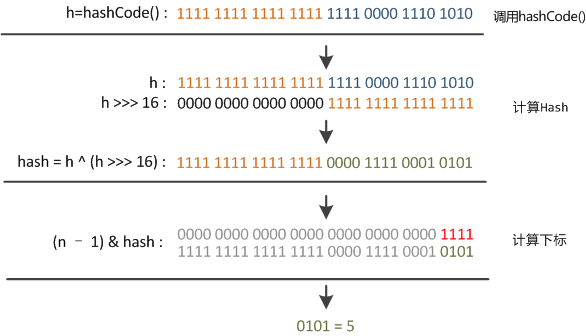
// 高16bit不变,低16bit和高16bit做了一个异或。
static final int hash(Object key) {
int h;
return (key == null) ? 0 : (h = key.hashCode()) ^ (h >>> 16);
}
// 返回数组下标
static int indexFor(int h, int length) {
return h & (length-1);
}
resize¶
当put时,如果发现目前的桶占用程度已经超过了Load Factor所希望的比例,那么就会发生扩容(resize)。在resize的过程,简单的说就是把bucket扩充为2倍,之后重新计算index,把节点再放到新的bucket中。resize的注释是这样描述的:
Initializes or doubles table size. If null, allocates in accord with initial capacity target held in field threshold. Otherwise, because we are using power-of-two expansion, the elements from each bin must either stay at same index, or move with a power of two offset in the new table.
// 扩容
void resize(int newCapacity) { //传入新的容量
Entry[] oldTable = table; //引用扩容前的Entry数组
int oldCapacity = oldTable.length;
if (oldCapacity == MAXIMUM_CAPACITY) { //扩容前的数组大小如果已经达到最大(2^30)了
threshold = Integer.MAX_VALUE; //修改阈值为int的最大值(2^31-1),这样以后就不会扩容了
return;
}
Entry[] newTable = new Entry[newCapacity]; //初始化一个新的Entry数组
transfer(newTable); //将数据转移到新的Entry数组里
table = newTable; //HashMap的table属性引用新的Entry数组
threshold = (int)(newCapacity * loadFactor);//修改阈值
}
// 将原有Entry数组的元素拷贝到新的Entry数组里。
void transfer(Entry[] newTable) {
Entry[] src = table; //src引用了旧的Entry数组
int newCapacity = newTable.length;
for (int j = 0; j < src.length; j++) { //遍历旧的Entry数组
Entry e = src[j]; //取得旧Entry数组的每个元素
if (e != null) {
//释放旧Entry数组的对象引用(for循环后,旧的Entry数组不再引用任何对象)
src[j] = null;
do {
Entry next = e.next;
//!!重新计算每个元素在数组中的位置
int i = indexFor(e.hash, newCapacity);
e.next = newTable[i]; //标记[1]
newTable[i] = e; //将元素放在数组上
e = next; //访问下一个Entry链上的元素
} while (e != null);
}
}
}
然而又因为我们使用的是2次幂的扩展(指长度扩为原来2倍),所以,元素的位置要么是在原位置,要么是在原位置再移动2次幂的位置。例如我们从16扩展为32时,具体的变化如下所示1:

因此元素在重新计算 hash 之后,因为n变为2倍,那么 n-1 的 mask 范围在高位多1bit(红色),因此新的index就会发生这样的变化:

因此,我们在扩充HashMap的时候,不需要重新计算hash,只需要看看原来的hash值新增的那个bit是1还是0就好了,是0的话索引没变,是1的话索引变成“原索引+oldCap”。可以看看下图为16扩充为32的resize示意图:
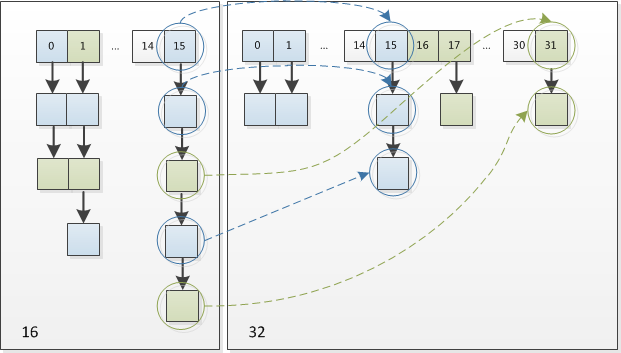
这个设计确实非常的巧妙,既省去了重新计算hash值的时间,而且同时,由于新增的1bit是0还是1可以认为是随机的,因此resize的过程,均匀的把之前的冲突的节点分散到新的bucket了。
线程不安全¶
HashMap是线程不安全的。
- 同时put碰撞导致数据丢失
- 同时put扩容导致数据丢失: 链表的死循环 https://coolshell.cn/articles/9606.html
- 死循环造成的CPU 100% (仅存在于JDK7及之前)
HashTable¶
SynchronizedMap¶
ArrayList和HashMap虽然不是线程安全的,但是可以用Collections.synchronizedList(new ArrayList<E>())和Collections.synchronizedMap(new HashMap<K, V>())可以使它们变成线程安全的类。原理是通过给原来的方法加上synchronized代码块。
private final Map<K,V> m; // Backing Map
final Object mutex; // Object on which to synchronize
public V get(Object key) {
synchronized (mutex) {return m.get(key);}
}
public V put(K key, V value) {
synchronized (mutex) {return m.put(key, value);}
}
ConcurrentHashMap和CopyOnWriteArrayList用来取代同步的HashMap和同步的ArrayList。绝大多数并发情况下,ConcurrentHashMap和CopyOnWriteArrayList的性能都更好。
ConcurrentHashMap¶
JDK7的ConcurrentHashMap最外层是多个Segment,每个Segment的底层数据结构与HashMap类似,仍然使用拉链法。每个Segment独立上ReentrantLock锁,每个Segment之间互不影响,提高了效率。
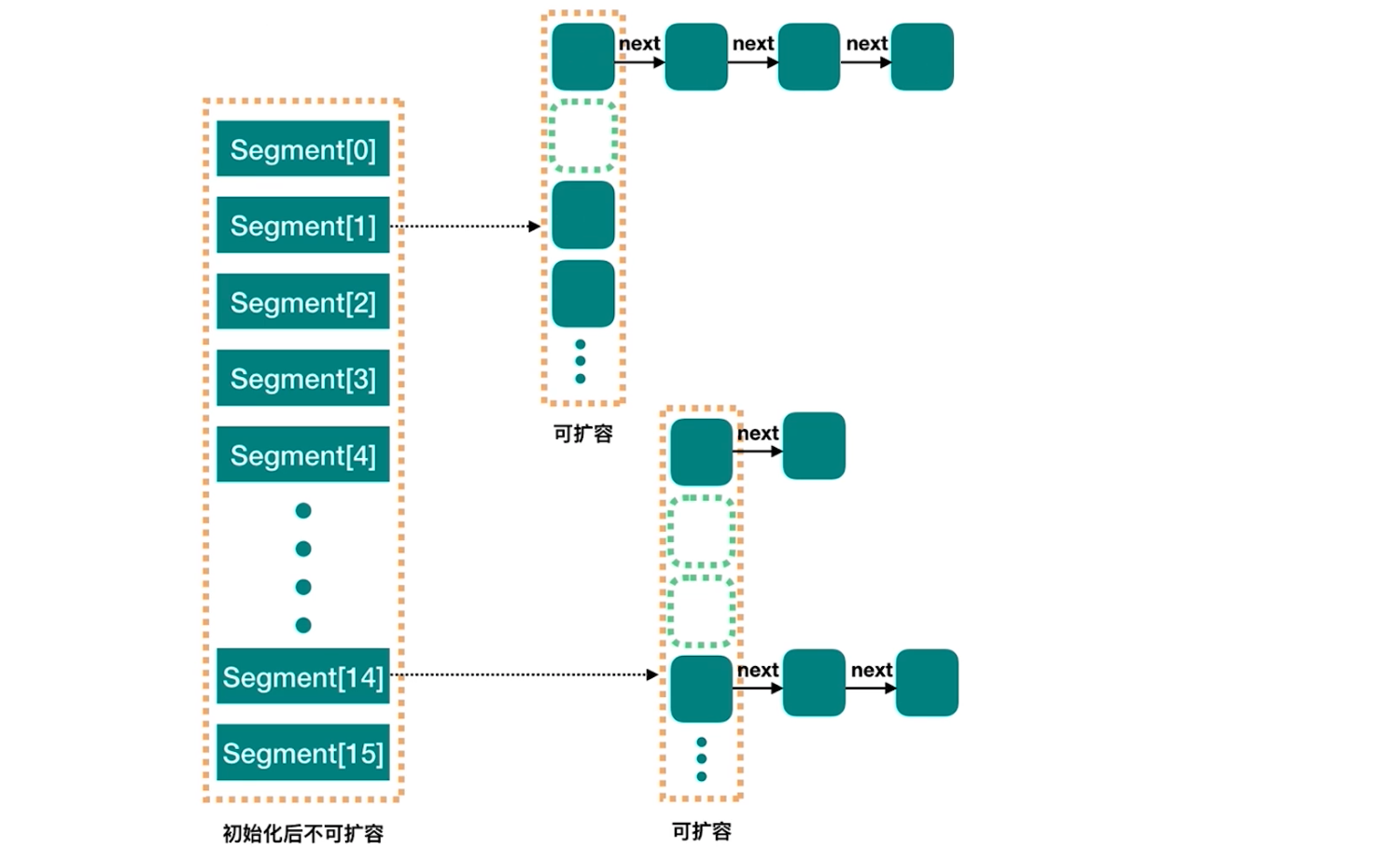
在JDK8中对ConcurrentHashmap进行了改进。取消segments字段,直接采用transient volatile Node<K,V>[] table保存数据,在table数组元素上加锁,从而实现了对每个桶进行加锁,进一步减少并发冲突的概率。并且采用了类似于对HashMap的改进,当链表长度大于阈值(TREEIFY_THRESHOLD)时,会转化为红黑树。
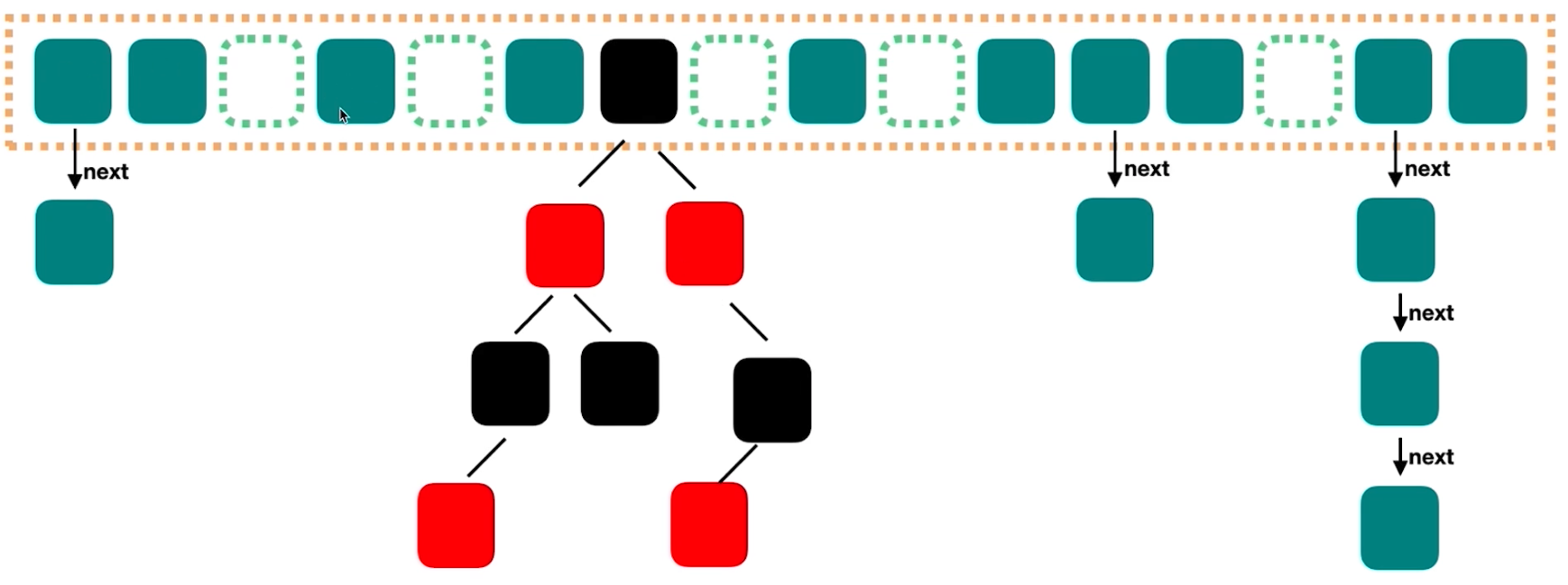
final V putVal(K key, V value, boolean onlyIfAbsent) {
if (key == null || value == null) throw new NullPointerException();
int hash = spread(key.hashCode());
int binCount = 0;
for (Node<K,V>[] tab = table;;) {
Node<K,V> f; int n, i, fh;
// 如果数组"空",进行数组初始化
if (tab == null || (n = tab.length) == 0)
tab = initTable();
// 找该 hash 值对应的数组下标为空
else if ((f = tabAt(tab, i = (n - 1) & hash)) == null) {
// 用一次 CAS 操作将这个新值放入其中
if (casTabAt(tab, i, null, new Node<K,V>(hash, key, value, null)))
break; // no lock when adding to empty bin
}
// hash等于 MOVED, 需要扩容
else if ((fh = f.hash) == MOVED)
// 帮助数据迁移
tab = helpTransfer(tab, f);
else {
V oldVal = null;
// 使用synchronzied锁写入数据
synchronized (f) {
if (tabAt(tab, i) == f) {
if (fh >= 0) { // 头结点的 hash 值大于 0,说明是链表
binCount = 1;
for (Node<K,V> e = f;; ++binCount) {
K ek;
// 如果发现了"相等"的 key,判断是否要进行值覆盖
if (e.hash == hash &&
((ek = e.key) == key ||
(ek != null && key.equals(ek)))) {
oldVal = e.val;
if (!onlyIfAbsent)
e.val = value;
break;
}
// 到了链表的最末端,将这个新值放到链表的最后面
Node<K,V> pred = e;
if ((e = e.next) == null) {
pred.next = new Node<K,V>(hash, key,
value, null);
break;
}
}
}
else if (f instanceof TreeBin) { // 红黑树
Node<K,V> p;
binCount = 2;
// 插入新节点
if ((p = ((TreeBin<K,V>)f).putTreeVal(hash,key,value)) != null) {
oldVal = p.val;
if (!onlyIfAbsent)
p.val = value;
}
}
}
}
if (binCount != 0) {
// 判断是否要将链表转换为红黑树,临界值和 HashMap 一样,也是 8
if (binCount >= TREEIFY_THRESHOLD)
treeifyBin(tab, i);
if (oldVal != null)
return oldVal;
break;
}
}
}
addCount(1L, binCount);
return null;
}
3 Queue¶
| 类 | 解释 |
|---|---|
BlockingQueue<E> |
添加和取出元素时发生阻塞的队列 |
ArrayBlockingQueue<E> |
以数组为基础的BlockingQueue |
LinkedBlockingQueue<E> |
以链表为基础的BlockingQueue |
PriorityBlockingQueue<E> |
带有优先级的BlockingQueue |
ConcurrentLinkedQueue<E> |
元素数量没有上限的线程安全的Queue |
Blocking Queue¶
BlockingQueue是一个先进先出的队列(Queue),为什么说是阻塞(Blocking)的呢?是因为 BlockingQueue 支持当获取队列元素但是队列为空时,会阻塞等待队列中有元素再返回;也支持添加元素时,如果队列已满,那么等到队列可以放入新元素时再放入。
BlockingQueue 对插入操作、移除操作、获取元素操作提供了四种不同的方法用于不同的场景中使用:1、抛出异常;2、返回特殊值(null 或 true/false,取决于具体的操作);3、阻塞等待此操作,直到这个操作成功;4、阻塞等待此操作,直到成功或者超时指定时间。总结如下:
| Throws exception | Special value | Blocks | Times out | |
|---|---|---|---|---|
| Insert | add(e) | offer(e) | put(e) | offer(e, time, unit) |
| Remove | remove() | poll() | take() | poll(time, unit) |
| Examine | element() | peek() | not applicable | not applicable |
对于 BlockingQueue,我们的关注点应该在 put(e) 和 take() 这两个方法,因为这两个方法是带阻塞的。BlockingQueue 是设计用来实现生产者-消费者队列的,它的实现都是线程安全的。
ArrayBlockingQueue¶
ArrayBlockingQueue 是底层由数组存储的有界队列。遵循FIFO,所以在队首的元素是在队列中等待时间最长的,而在队尾的则是最短时间的元素。新元素被插入到队尾,队列的取出 操作队首元素。
这是一个经典的有界缓存,由一个长度确定的数组持有所有由生产者插入、由消费者取出的元素。一旦创建,整个队列的容量将不会改变。尝试向一个已满的队列 put 将会导致调用被阻塞,同样的向一个空队列 take 也会阻塞。
该队列支持队等待的生产者和消费者实施可选的公平策略。默认情况下,是非公平策略。可以通过构造函数来指定是否进行公平策略。一般情况下公平策略会减小吞吐量,但是也会降低可变性以及防止饥饿效应。
ArrayBlockingQueue 内部使用了 ReentrantLock 以及两个 Condition 来实现。
/** Main lock guarding all access */
final ReentrantLock lock;
/** Condition for waiting takes */
private final Condition notEmpty;
/** Condition for waiting puts */
private final Condition notFull;
PUT 方法也很简单,就是 Condition 的应用。
public void put(E e) throws InterruptedException {
checkNotNull(e);
final ReentrantLock lock = this.lock;
lock.lockInterruptibly();
try {
//队列已满,wait 在 condition 上
while (count == items.length)
notFull.await();
enqueue(e);
} finally {
lock.unlock();
}
}
private void enqueue(E x) {
// assert lock.getHoldCount() == 1;
// assert items[putIndex] == null;
final Object[] items = this.items;
items[putIndex] = x;
if (++putIndex == items.length)
putIndex = 0;
count++;
notEmpty.signal();
}
take 方法也同样的。
public E take() throws InterruptedException {
final ReentrantLock lock = this.lock;
lock.lockInterruptibly();
try {
//队列为空,wait 在 condition 上
while (count == 0)
notEmpty.await();
return dequeue();
} finally {
lock.unlock();
}
}
private E dequeue() {
// assert lock.getHoldCount() == 1;
// assert items[takeIndex] != null;
final Object[] items = this.items;
@SuppressWarnings("unchecked")
E x = (E) items[takeIndex];
items[takeIndex] = null;
if (++takeIndex == items.length)
takeIndex = 0;
count--;
if (itrs != null)
itrs.elementDequeued();
notFull.signal();
return x;
}
LinkedBlockingQueue¶
LinkedBlockingQueue是基于单向链表实现的阻塞队列。
// 队列容量
private final int capacity;
// 队列中的元素数量
private final AtomicInteger count = new AtomicInteger(0);
// 队头
private transient Node<E> head;
// 队尾
private transient Node<E> last;
// take, poll, peek 等读操作的方法需要获取到这个锁
private final ReentrantLock takeLock = new ReentrantLock();
// 如果读操作的时候队列是空的,那么等待 notEmpty 条件
private final Condition notEmpty = takeLock.newCondition();
// put, offer 等写操作的方法需要获取到这个锁
private final ReentrantLock putLock = new ReentrantLock();
// 如果写操作的时候队列是满的,那么等待 notFull 条件
private final Condition notFull = putLock.newCondition();
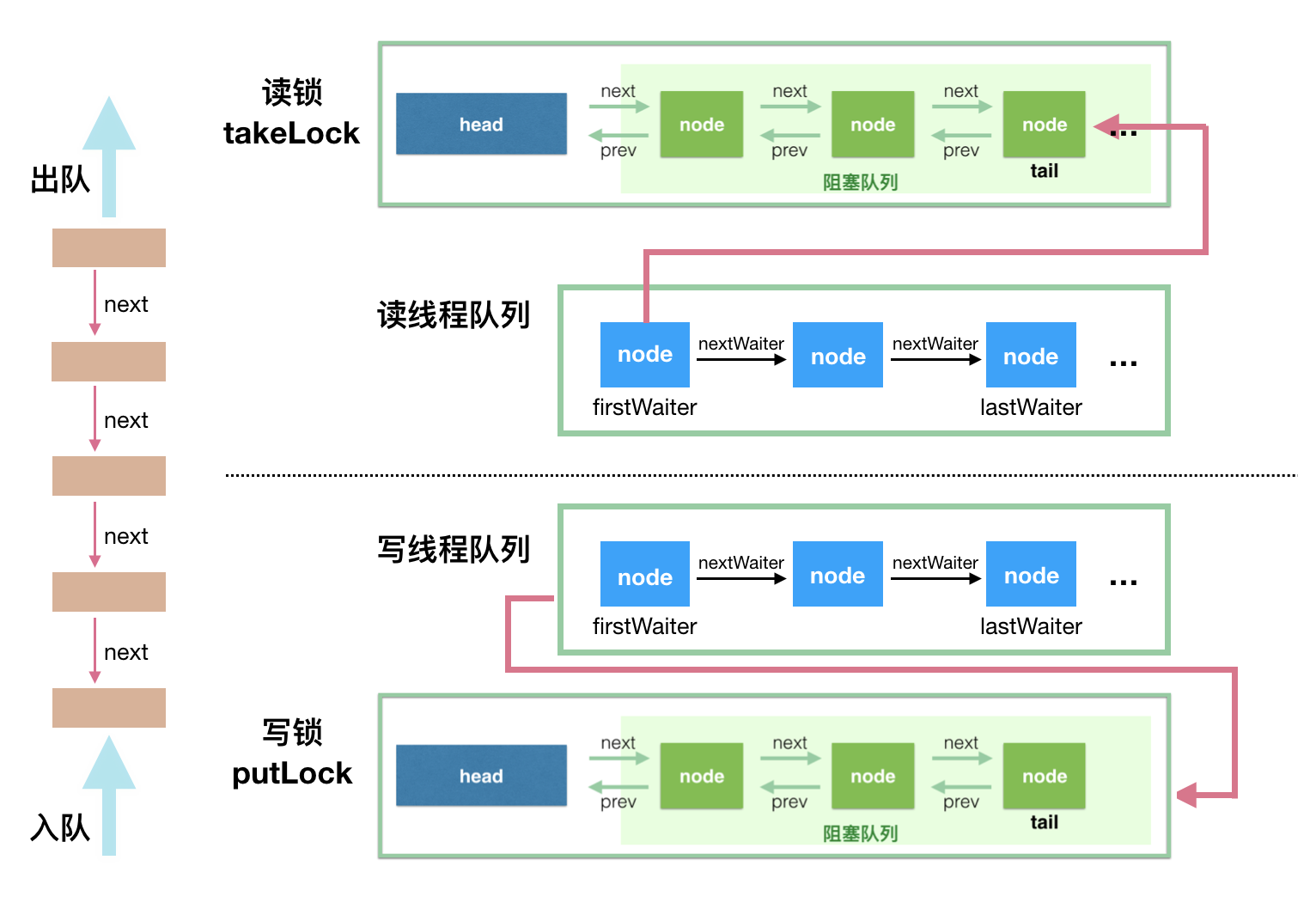
LinkedBlockingQueue.take使用了原子类型AtomicInteger和重入锁ReentrantLock来保证线程安全:
public E take() throws InterruptedException {
E x; // 定义x
int c = -1;
final AtomicInteger count = this.count; // 队列大小
final ReentrantLock takeLock = this.takeLock; // 获取出队锁
takeLock.lockInterruptibly(); // lock
try {
// 如果没有元素,一直阻塞
while (count.get() == 0) {
// 加入等待队列, 一直等待条件notEmpty(即被其他线程唤醒)
// 唤醒其实就是,有线程将一个元素入队了,
// 然后调用notEmpty.signal()唤醒其他等待这个条件的线程,同时队列也不空了
notEmpty.await();
}
x = dequeue(); //出队
c = count.getAndDecrement(); // 队列大小 -1
if (c > 1) // 通知队列非空
notEmpty.signal();
} finally { //unlock
takeLock.unlock();
}
if (c == capacity)
signalNotFull();
return x;
}
SynchronousQueue¶
Synchronous指的就是读线程和写线程需要同步:当一个线程往队列中写入一个元素时,写入操作不会立即返回,需要等待另一个线程来将这个元素拿走;同理,当一个读线程做读操作的时候,同样需要一个相匹配的写线程的写操作。
https://www.javarticles.com/2016/06/java-synchronousqueue-example.html
